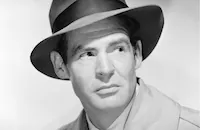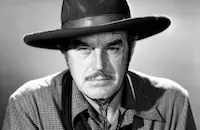Trail Street

Brief Synopsis
Cast & Crew
Ray Enright
Randolph Scott
Robert Ryan
Anne Jeffreys
George "gabby" Hayes
Madge Meredith
Film Details
Technical Specs

Synopsis
In the late nineteenth-century, the town of Liberal, Kansas is under siege by trail riders, outlaws who have been hired by cattlemen to terrorize farmers and drive livestock across their parched fields. At the request of Allen Harper, the area's biggest land investor, Billy Burns has written to his friend, U.S. Marshal Bat Masterson, for help. Allen and Billy hope that the legendary lawman will assume the job of sheriff and bring law and order to the town. Allen also hopes that his sweetheart, Susan Pritchard, will not return to the East with crooked cattleman Logan Maury as she has threatened, but will brave the tough times in Liberal with him. When Lance Larkin, one of Maury's henchmen, begins beating up a farmer in the middle of the street, Allen comes to his rescue and is aided by Bat, who has just arrived in town. Liberal's mayor formally appoints Bat sheriff, and Bat makes a reluctant Billy his deputy. As Bat, Billy and Allen then discuss farmer Tim McKeon's secret plans to grow drought-resistant crops, Larkin listens from his jailhouse cell and relays the news to Maury. When Allen and Billy visit the feisty Tim, who was injured battling the trail riders, Allen insists that he borrow his gun for protection. In town, meanwhile, Maury tries to bribe Bat to take his side, but Bat stoutly refuses and easily thwarts Maury's attempt on his life. Later, Allen is visited at home by Ruby Stone, a saloon singer who is in love with Maury. Jealous of Susan, Ruby, who has known Allen since childhood, warns him about her involvement with Maury and angrily leaves. Ruby's departure is witnessed by Hannah, Allen's nosey neighbor, and when Susan sees Hannah the next day, she gleefully informs her about the visit. Susan, who is unaware that Allen's parents adopted Susan as a child, snubs Allen at her birthday party that night and dances with Maury. Later, Susan refuses to listen to Allen's explanations and informs him that she is leaving the next day with Maury. Bat, meanwhile, learns that Tim has been murdered with Allen's gun and that a mob, led by crooked saloon keeper Carmody, is forming to lynch Allen. Sure that Larkin, whom he released earlier from jail, is the killer, Bat rushes to Allen's and, after deputizing him, sends him to the next county to find Larkin. To Carmody's chagrin, Bat, who has issued a "no gun" ordinance in Liberal, then deflates the mob. Allen, meanwhile, captures Larkin at a farmhouse and learns that the farm couple's son has planted winter wheat in the blazing Kansas sun and has successfully raised a crop. Ecstatic, Allen rides back to Liberal with Larkin and a bag of wheat seed, but soon discovers that most of the poor farmers have just sold their mortgages to Maury. When the townspeople and farmers become aware of Maury's legal "cheat," they eagerly align themselves with Bat, who plans to trap Maury by announcing his intention to try Larkin for Tim's murder. As predicted, Maury rallies his men to attack Liberal and free Larkin, but they are stopped by Bat, Allen, a forgiving Susan and an army of angry farmers. Ruby, who is no longer in love, then informs Maury that she burned his unrecorded land sales receipts and has consequently made his purchases null and void. Furious at Ruby's betrayal, Maury shoots her in the back, but is then killed by his own men, who condemn him as a "woman killer." With law and order installed in Liberal, Bat heads for the East to become a journalist, while Susan and Allen marry and Billy is named the new sheriff.

Director
Ray Enright
Cast

Randolph Scott

Robert Ryan

Anne Jeffreys

George "gabby" Hayes

Madge Meredith
Billy House
Virginia Sale

Harry Woods
Phil Warren
Harry Harvey
Elena Warren
Betty Hill
Larry Mcgrath
Warren Jackson
Billy Vincent
Howard Mccrorey
Lew Harvey
Glen Mccarthy
Ernie Adams
Al Murphy
Kit Guard
Bob O'connor
Bert Lebaron
Roy Butler
Frank Austin
Carl Wester
Sam Lufkin
Joe Brockman
Guy Beach
Jessie Arnold
Paul Dunn
Donald Olsen
Eugene Persson
Si Jenks
Donald Kerr
Michael Austin
Willow Bird
Stanley Andrews
Sarah Padden
Frank Mcglynn
Crew
James Anderson
C. Bakaleinikoff
Adele Balkan
Ralph Berger
Lyle Boyer
Harry Braisted
Stanley Carter
Russell A. Cully
Albert S. D'agostino
Jack J. Gross
Nat Holt
Norman Houston
J. Roy Hunt
Terry Kellum
Gene Lewis
Ben Oakland
Harold Palmer
Grayson Rogers
Paul Sawtell
Darrell Silvera
Jean L. Speak
John Sturtevant

Videos
Movie Clip


Film Details
Technical Specs

Articles
Trail Street (1947)
A Virginian by birth, Randolph Scott started his career coaching Gary Cooper in his native dialect for the Western The Virginian (1929). His earliest roles were usually as dashing romantic types, but in the 30s he made a number of medium-budget Westerns at Paramount that were realistic, adult-oriented stories similar to those made by such silent-era stars of the genre as William S. Hart and Harry Carey. By the late 40s he had moved almost exclusively into Western roles and became the unofficial "King of the Cowboys" in the decade to follow. In 1946 he teamed with producer Nat Holt to make a series of profitable Westerns, including this one. Scott's popularity kept him among the top 25 stars for 20 years and placed him among the top 10 box office draws for several years in the 1950s. His work in a series of films directed by Budd Boetticher stand among the most respected of the Western genre. Before retiring from acting in 1962, he made his next-to-last picture with Boetticher, Comanche Station (1960), and appeared for the last time on screen in Ride the High Country (1962), directed by Sam Peckinpah, who would begin creating a new type of Western for a new age. Scott was inducted into the Hall of Great Western Performers of the National Cowboy and Western Heritage Museum in 1975, and his identification with the genre was so strong that whenever his name was mentioned in Mel Brooks' spoof Blazing Saddles (1974), it was accompanied by a reverential heavenly chorus.
Chicago-born Robert Ryan was an Ivy League graduate and heavyweight boxer who bounced around in a number of odd jobs before landing in Hollywood in 1939. Trained at Max Reinhardt's Actors' Workshop, he found steady work in small parts and got his first big break playing Ginger Rogers' husband in Tender Comrade (1943). His enlistment in the Marines in 1944 temporarily halted his career; Trail Street was his first film after returning from the war. He quickly rose to major stardom, often playing a man whose rugged good looks concealed a tormented and twisted inner nature. But he also became most associated in audience's minds with Westerns, thanks to what Ryan called his "long, seamy face." Throughout the 50s and 60s he made a number of acclaimed films in the genre with such directors as Boetticher, Anthony Mann, Raoul Walsh, John Sturges and Andre De Toth. He also worked with Peckinpah in the landmark Western The Wild Bunch (1969).
Also appearing in this film is another icon of the genre, George "Gabby" Hayes, who brought to the story the grizzled comic relief that made him famous as Roy Rogers' sidekick. Reviewers at the time took particular delight in the outlandish tall tales Hayes tells in Trail Street, about such questionable legends as Texas grasshoppers so big they can pick their teeth with barbed wire. And look for the father of stage and screen actor Jason Robards in a smaller role as "Jason."
Ray Enright directed Scott three times prior to this project, most notably teaming him with John Wayne and Marlene Dietrich in The Spoilers (1942). He also directed Ryan earlier in the football drama The Iron Major (1943). Trail Street was such a hit that the director and the two stars teamed again -along with Hayes, fellow cast member Anne Jeffreys and cinematographer J. Roy Hunt -for Return of the Bad Men (1948). In that picture, Ryan played the legendary Sundance Kid, a role played by numerous actors throughout film history, the most famous being Robert Redford's portrayal in Butch Cassidy and the Sundance Kid (1969).
Director: Ray Enright
Producer: Nat Holt
Screenplay: Norman Houston, Gene Lewis, based on the novel Golden Horizon by William Corcoran
Cinematography: J. Roy Hunt
Editing: Lyle Boyer
Art Direction: Ralph Berger, Albert S. D'Agostino
Original Music: Harry Braisted, Stanley Carter, Ben Oakland, Paul Sawtell
Cast: Randolph Scott (Bat Masterson), Robert Ryan (Allan Harper), George "Gabby" Hayes (Billy Burns), Anne Jeffreys (Ruby Stone), Madge Meredith (Susan Pritchett).
BW-85m.
by Rob Nixon

Trail Street (1947)
Quotes
You think you got some pretty tough fellas over there in Dodge City. I guess you ain't never heard of Dry Gulch Curly have you? You see, old Brandyhead Jones, he was a United States Marshal, too. He done all the hanging over in our neighborhood. And this Dry Gulch I'm telling you about -- he was so tough that when Old Brandyhead hung him, his trigger finger kept jerking for two hours after he was dead.- Billy Burns
What do you want, Carmody?- Marshal Bat Masterson
Look here, Bat. These citizens here have elected me spokesman....- Carmody
Listen, fella, there's only two kind of people I allow to call me Bat: good friends and people I like. You don't belong in either group.- Marshal Bat Masterson
Trivia
Notes
William Corcoran's novel was published as a serial in Cosmopolitan under the title Trail Street. RKO sound man Jean L. Speak's name was incorrectly listed as James L. Speak in the opening credits. As depicted in the film, Kansas became a wheat producing state after a heat resistant strain was introduced to the land. The strain, which was brought in by Mennonite settlers, was called Turkey Red. The real Bat Masterson was the sheriff of Dodge City from 1877 to 1879. After he was voted out of office, he went to Tombstone, AZ, with Wyatt Earp, but returned to Dodge City in 1883 to help gambler friend Luke Short fight local reformers in the "Dodge City War." From then until the end of the century, Masterson was a professional gambler in Colorado. As depicted in the film, Masterson aspired to a writing career and, at the end of his life, became a drama critic and sports reporter in New York. For more information about Masterson, for the 1943 United Artists release The Woman of the Town.
According to Hollywood Reporter news items, Barbara Hale and Lawrence Tierney were first cast as the picture's stars. Lee Frederick, an ex-serviceman and a former pitcher for the Chicago Cubs, was announced as a cast member in Hollywood Reporter, but his participation in the final film has not been confirmed. In August 1946, Hollywood Reporter announced that five hundred extras had been hired for the fight scene between the farmers and the trail riders. The Liberal, KS premiere featured a four-mile parade with twelve bands, Indians from the Annadarko reservation, soldiers from Fort Riley, as well as cowboys, stagecoaches and other western regalia. Modern sources note that the film made $365,000 at the box office.














